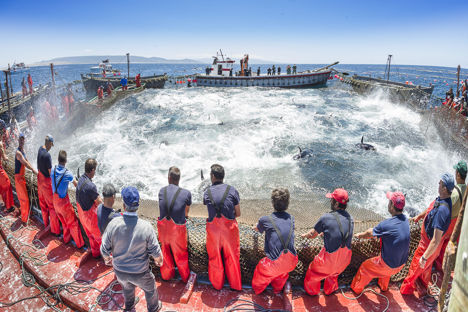
Ingredient Focus: wild almadraba bluefin tuna
The Spanish town of Barbate in Cádiz is famed for its bluefin tuna, caught using the unique almadraba method, which ensures meat of the highest quality. Rachel McCormack travels to Cádiz to find out more. Photography by Julio Gonzalez
Ingredient Focus: wild almadraba bluefin tuna
The Spanish town of Barbate in Cádiz is famed for its bluefin tuna, caught using the unique almadraba method, which ensures meat of the highest quality. Rachel McCormack travels to Cádiz to find out more. Photography by Julio Gonzalez
According to Greek mythology Cádiz, or Gadir as it was originally known, was created by Hercules after he performed his tenth labour and had travelled to the end of the world to capture the monster Geryon’s cattle. Lying beyond the straits of Gibraltar, beyond the Pillars of Hercules on the southern Atlantic coast of Spain, Cádiz for the Ancients was the edge of the world.
Settled since the seventh century BC, both the city and the province of Cádiz are the geographical link between the Atlantic and the Mediterranean and one of its most important industries, recorded even before the arrival of the Phoenicians, has been the capture and processing of Atlantic bluefin tuna. This bluefin tuna lives in the Eastern Atlantic but returns to the Mediterranean to spawn in May and June and passes through the Cádiz coastal waters. This is the moment that the tuna are in peak condition and when they are caught in Cádiz.
These giant fish generally weigh 220-225 kilograms but can reach weights far higher. Catching a fish that big, capable of swimming up to sixty-two kilometres per hour against the tide was always going to be a complicated business and since ancient times an ingenious method, called almadraba, of catching these creatures has been used. Today’s almadraba system is based on methods developed in the early nineteenth century and is a complex labyrinth of nets, some as long as three kilometres, which are often set up weeks before the arrival of the tuna. The tuna are trapped in this labyrinth, which also acts as a filter to enable smaller tuna and other species to escape, in a space called the copa. They are then cornered into a smaller area by a ring of five small boats who pull up the nets to gather up the tuna. The tuna is then immediately killed to avoid stressing the animals, before they are taken out the water to be processed immediately in large, iced containers, with the aim of maintaining the high quality of the tuna meat.
The expert in this modern tuna industry is Rocío Vallejo Carmona of Cádiz university who studies the impact of bluefin tuna on the region. ‘In this area we had forgotten how to appreciate bluefin tuna until recently,’ Rocio tells me. ‘Once we caught the tuna it was mostly preserved in tins and the parts of the fish that the canning industry didn’t want were then used for a few local tapas dishes.’ The town of Barbate, the centre of today’s almadraba industry, was most famous for sardines during the latter half of the twentieth century. The change came when Japanese tuna hunters arrived looking for bluefin tuna towards the end of the seventies and the industry slowly started again, with the Japanese buying up most of the catch and taking it back home in frozen containers.
‘We really have to be grateful to the Japanese.’ says Rocío. ‘They did us the great favour of reminding us of what we had on our doorstep. Over the years our interactions with them taught us how they immediately froze the tuna to keep all its properties, while we taught them to appreciate parts of the tuna that they hadn’t before.”
In 2006, Frialba, a local company created by the Almadraba fishermen who started to realise just what the Japanese appreciated, opened in Barbate allowing them to process the tuna themselves. Nowadays, a tuna can be cut up, processed and frozen at minus sixty degrees in less than two hours, thus maintaining the highest quality of meat, which is now transported throughout Spain and abroad to be enjoyed at some of the best restaurants in the world. Wild bluefin tuna from Barbate is preserved in cans and jars in oil as well as the old-fashioned way with lard. One of the glories of Cádiz is mojama, air-dried tuna loin made from this almadraba tuna (now with its own geographically protected status), thinly sliced with some extra virgin olive and some toasted almonds.
While the capital of the province celebrates the almadraba by showcasing tuna dishes on menus across the city, it’s Barbate that really lives the tuna culture. Barbate has a tuna festival every year the week before the tuna arrive. There are cooking demonstrations, a bluefin tuna tapas route, round table discussions, flamenco and late-night open air clubbing, all to welcome the annual arrival of the tuna. All year round one of the most famous tuna restaurants in Barbate, El Campero, has over thirty different types of tuna cuts and dishes on their menu. ‘The thing is,’ Rocío tells me, ‘we really know how to live in Spain and we really know how to eat. All it took was some reminding and now we have some great food and a great festival.’

